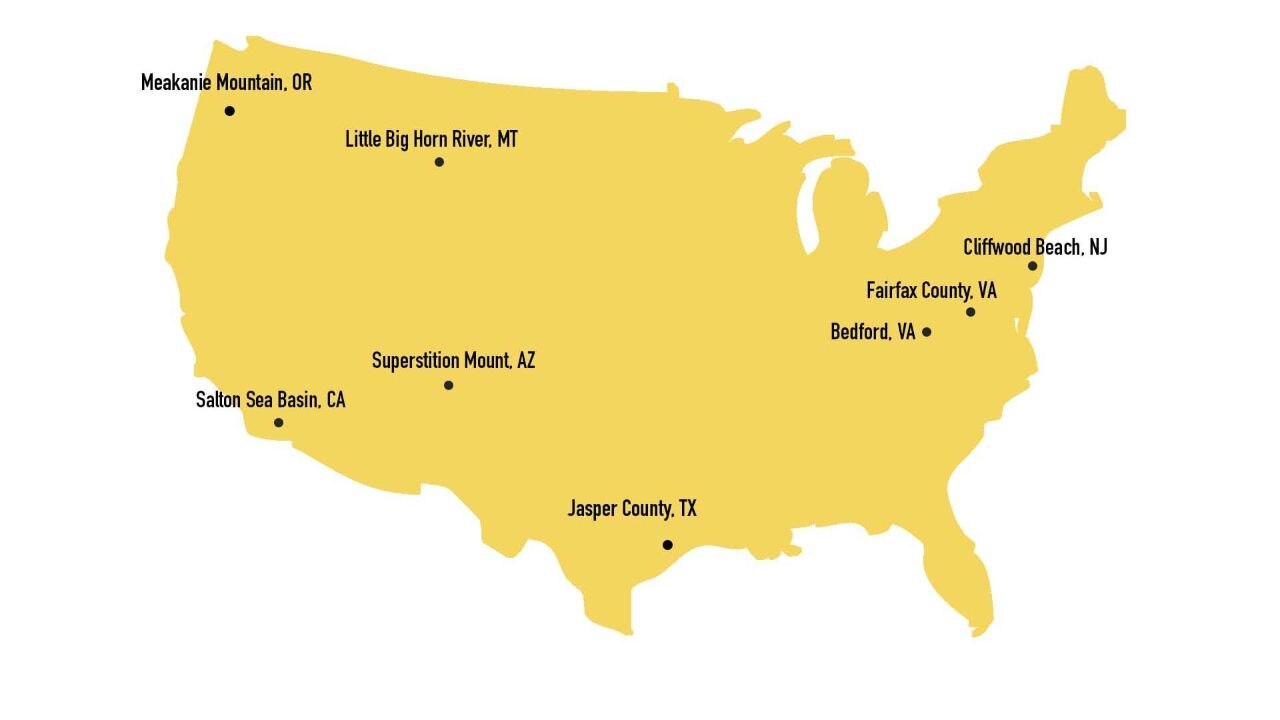Eight Buried Treasures That You May Still Be Able to Dig Up

Story by Jesse Hirsch
Jesse is an editor for Pursuits with Enterprise, as well as for Los Angeles-based GOOD magazine. He lives in Brooklyn, where he writes about food, agriculture and travel.
Mystery or urban legend — you be the judge.
Not all hidden treasures come with as many clues as the legendary stash left in the Rockies by adventurer Forrest Fenn. Fenn left a string of riddles to pursue, tantalizingly dangling his bounty in front of legions of thrill-seekers. What many don’t realize is that the U.S. is flush with other (supposed) buried treasures. Some come with cryptic clues left by impresarios like Fenn, while others are word-of-mouth legends passed down for decades or centuries, fodder for endless quests.
We can’t verify the authenticity of any of these treasures; no one can, really. Each tale comes with its own level of plausibility, and its own long history of frustrated seekers. But there’s one thing they all have in common: the opportunity for a fun adventure that takes you outside your day-to-day, customary existence. And just imagine how glorious it could be to be the one dogged adventurer who managed to crack one of these American mysteries. Also — you’ll be rich! Happy hunting.
The Beale Ciphers — Bedford County, Virginia
Dating back to the 1820s, the Beale Ciphers describe the location of a gold treasure now estimated at upward of $43 million. As the legend goes, a man named Thomas Jefferson Beale buried the treasure, wrote three coded “ciphertexts” and left them with a friend. These ciphertexts were published in an 1885 pamphlet, available for purchase. Only one of the three texts has been decoded, which indicated what was actually buried in the box. The other two ciphertexts are supposed to contain information on exactly where to find the treasure, as well as the treasure owners’ next of kin. Some critics have raised doubt about the existence of this treasure, but as no one has been able to decode the text yet, it’s still an open question. Are you a master code breaker? Give it a shot!
The Tillamook Treasure — Neahkanie Mountain, Oregon
This buried treasure has a range of back stories, all of them outrageous and colorful. The baseline story is that something happened to a Spanish ship in Nehalem Bay, Oregon, in the late 1600s. Was it a shipwreck? Mutiny? A captain-led mass murder? Hard to say, but passionate treasure seekers certainly cling to the veracity of the booty. Lewis and Clark were among the first to hear of this legend during their explorations; the story has taken fire since then. This one was the basis for the award-winning 2006 film "The Tillamook Treasure," which prompted still more seekers to visit the mountain. The government of Oregon has forbidden digging on the part of the mountain where the treasure supposedly lies, but that hasn’t stopped many people from trying!
Captain Kidd’s Treasure — Cliffwood Beach, New Jersey
The legend of Captain William Kidd is long, elaborate and full of contradictions. He was a pirate, executed in Great Britain in 1701, which is really when the legend began. He had allegedly stashed parts of his treasure around the world, and indeed a stash worth over $1 million dollars was uncovered in Long Island shortly after his death. Another of his stashes was discovered near Madagascar in 2015, and there is credible evidence that New Jersey may house some lingering gold. “Kidd’s Rangers,” two elm trees near Cliffwood Beach that the captain used for navigation purposes, have long steered treasure seekers in that direction. And 17th-century Spanish gold coins have been found on an island just offshore the beach, as well as at an inland pond. Want to look yourself? Hit Cliffwood Beach with a metal detector!
Lost Ship in the Desert — Salton Sea Basin, California
Anyone interested in quirky geological phenomena probably knows about the Salton Sea already, an inland saltwater sea that was once a tourist hub and is now a rapidly drying, smelly mess. But centuries before its present-day incarnation, the basin was home to Lake Cahuilla, a freshwater lake with connections to larger waterways. As legend would have it, a 16th-century Spanish galleon, on the run from pirates, ran aground at Lake Cahuilla, losing its bounty of pearls and gold. Various stories have emerged over the years of travelers stumbling upon remains of the wreckage or catching a glimpse but never being able to retrace their steps. This one bears all the hallmarks of urban legend, but that doesn’t stop dedicated treasure hunters from prowling the empty sea basin. (Adding to evidence it might just be a myth: Some claim it’s a Viking ship.)
Fletcher’s Treasure – Jasper County, Texas
The legend of John Fletcher’s treasure is wild and whimsical, based on a letter — dated from 1816 — in the possession of a W.S. Glenn of Palestine, Texas. Long story short — the letter, allegedly from John Fletcher, tells the tale of 12 prospectors who buried a lot of Spanish silver and gold in a creek bed. Of course, the prospectors were all killed, except for Fletcher. He also included a crude little map of how to find the tiny creek, but apparently it wasn’t a great map. Centuries later, no one has found the treasure. Not for lack of searching!
Custer’s Treasure — Little Bighorn River, Montana
A Civil War ship captain named Grant Marsh had a tricky decision to make — he was tasked with rescuing many of the bloodied soldiers from Custer’s legendary battle, but he also had $375,000 worth of gold on board his ship. Choosing humans over hubris, Marsh allegedly stowed his treasure along the banks of this winding Montana river. Historians debate particularities of this account, though many agree there was gold on board Marsh’s ship, and it’s certainly never been found. Feeling lucky?
Lost Dutchman’s Mine — Superstition Mountains, Arizona
This one revolves around the legend of Jacob Walz, a German wanderer who was nicknamed “The Dutchman” because of cultural confusion. Somewhere around 1860, Walz purchased a plot of mountainous land in the Southwest; a very productive gold vein was allegedly found on this land. On his deathbed, he reportedly gave cryptic instructions (there are clues!) to the woman nursing him. She never found the mine, and neither has anyone else. But take caution — the search can be dangerous.
Mosby’s Treasure — Fairfax County, Virginia
John Mosby was a Confederate raider, and his most legendary siege occurred in 1863 at the courthouse in Virginia’s Fairfax County. He rode away with dozens of captured Confederate soldiers, as well as $350,000 (an incredibly vast sum at the time). Mosby and a Confederate sergeant allegedly buried the treasure in a sack between two pine trees that they marked with a cross. As the story goes, he told loved ones on his deathbed that he always meant to go back and dig up that treasure. Apparently he ... forgot? Sounds likely.
Hidden Treasure
John and his son Amory search for hidden treasure stashed in the Rocky Mountains.
The Legend of Forrest Fenn
The swashbuckling art dealer who hid a $2 million treasure has led a wild life.
New Mexico Must-Sees
Discover some of the state's hidden gems.

Start A Reservation
Enjoy fast and easy car rental bookings from Enterprise Rent-A-Car at one of our 7,200 branches in cities, airports and neighborhoods near you.
Reserve Now
Email Offers
Don't miss an excuse to hit the road: our latest offers delivered to your inbox.
Sign Up







